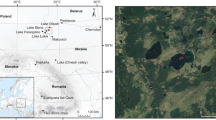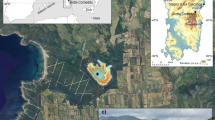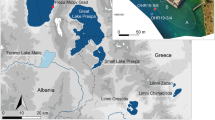Abstract
To better understand the response of forest vegetation to climate and fire regimes with reference to human activities over the last deglacial period in the Aso Caldera, central Kyushu, southwestern Japan, a 33.9 m long sediment core was examined in order to reconstruct the vegetational and fire history using pollen and charcoal analyses. The results show that a cool temperate broad-leaved deciduous forest, dominated by Quercus (deciduous oaks) with Carpinus and Fagus, prevailed in the Aso Valley from ca. 14.6 ka cal. b.p., indicating warming since the last glacial period. The landscape was presumably covered by a mosaic of deciduous Quercus forests and terrestrial Artemisia communities. Around 12.8–11.7 ka cal. b.p., Quercus dominated the forest and fires occurred frequently. Co-expansion of distinctive Ulmus–Zelkova and Celtis–Aphananthe forests coupled with a progressive retreat of Quercus in the early Holocene could reflect a strengthening of the East Asian summer monsoon under mild and humid climate conditions. Around 8 ka cal. b.p., significant increases in Cyclobalanopsis (evergreen oaks), Castanopsis/Castanea and Podocarpus indicate a further warming, in particular an increased winter temperature. Warm temperate lucidophyllous forests, dominated by Cyclobalanopsis, flourished after 7.3 ka cal. b.p., probably corresponding to the “Holocene Climatic Optimum” interval. Progressive expansion of Quercus at the expense of Cyclobalanopsis began around 6.4 ka cal. b.p. and paralleled an increase in charcoal until ca. 4.8 ka cal. b.p.; this could be evidence of fire disturbance induced by the early-middle Jomon people. The disturbed evergreen forest experienced a temporary recovery but then opened again from 3.6 ka cal. b.p. due to extensive fire deforestation, as suggested by the high charcoal levels during this time. Human exploitation and buckwheat (Fagopyrum) agriculture may have contributed to the opening of the forest, which allowed secondary forests (primarily Pinus and Quercus) and herbaceous communities (mainly Poaceae) to spread. These results are discussed in comparison with other high-resolution pollen data from western Japan to better elucidate the vegetation and fire history over the last deglacial in the Aso Caldera.







Similar content being viewed by others
References
Faegri K, Iversen J (1989) Textbook of pollen analysis, IV edn. Wiley, Chichester
Furutani M (1979) Studies on the forest history in the Osaka area since Würm glacial age in Japan. Quat Res 18:121–141 (in Japanese with English abstract)
Gotanda K, Yasuda Y (2008) Spatial biome changes in southwestern Japan since the last glacial maximum. Quat Int 184:84–93
Grimm EC (1991–1993) Tilia version 2.0. Illinois State Museum, Research and Collections Centre, Springfield
Hase Y, Miyabuchi Y, Haruta N, Sasaki N, Yumoto T (2010) Change of sedimentary facies and topographic process after the late period of the last glacial age of Aso in the central Kyushu, Japan. Bull Goshoura Cret Mus 11:1–10 (in Japanese)
Hase Y, Iwauchi A, Uchikoshiyama U, Noguchi E, Sasaki N (2012) Vegetation changes after the late period of the last glacial age based on pollen analysis of the northern area of Aso Caldera in central Kyushu, southwest Japan. Quat Int 254:107–117
Hayashi R, Takahara H, Hayashida A, Takemura K (2010) Millennial-scale vegetation changes during the last 40,000 yr based on a pollen record from Lake Biwa, Japan. Quat Res 74:91–99
Hayashi R, Inoue J, Makino M, Takahara H (2012) Vegetation history during the last 17,000 years around Sonenuma Swamp in the eastern shore area of Lake Biwa, western Japan: with special reference to changes in species composition of Quercus subgenus Lepidobalanus trees based on SEM pollen morphology. Quat Int 254:99–106
Inoue J, Takahara H, Chijiwa K, Yoshikawa S (2005) Fire history since 17,000 yr BP reconstructed from charcoal particles analysis of the Sonenuma Swamp sediments, Shiga Prefecture, Japan. Jpn J Hist Bot 13:47–54 (in Japanese with English abstract)
Institute of Botany and South China Institute of Botany, Academia Sinica (1982) Angiosperm pollen flora of tropical and subtropical China. Science Press, Beijing, p 453 (in Chinese)
Iwauchi A, Hase Y (1992) Vegetational changes after the last glacial age in the Kumamoto Plain and Aso Caldera areas. Jpn J Palynol 38:116–133 (in Japanese with English abstract)
Japan Meteorological Agency (2012) Normals for the period 1981–2010. http://www.data.jma.go.jp/obd/stats/etrn/index.php
Kawano N, Kawano K, Ohsawa M (2009) Floristic diversity and the richness of locally endangered plant species of semi-natural grasslands under different management practices, southern Kyushu, Japan. Plant Ecol Divers 2:277–288
Kawano T, Sasaki N, Hayashi T, Takahara H (2012) Grassland and fire history since the late-glacial in northern part of Aso Caldera, central Kyushu, Japan, inferred from phytolith and charcoal records. Quat Int 254:18–27
Kira T (1945) A new classification of climate in eastern Asia as the basis for agricultural geography. Horticultural Institute, Kyoto University, Kyoto (in Japanese)
Kitagawa Y, Yoshikawa S, Takahara H (2009) Vegetation history in Osaka Bay watershed areas during the Holocene reconstructed from pollen analysis of Yumeshima-oki core, Osaka Bay, Japan. Quat Res 48:351–363 (in Japanese with English abstract)
Kobayashi K, Niwa E, Itō S, Hirota M, Setani K, Zaur L, Ineza J, Sasaki Y (2011) Radio carbon dating of Miyayama archaeological site (the IV Chapter—physical and chemical analysis). In: Aso Education Committee, Miyayama archaeological site II (the 2nd volume of Aso Cultural Survey Report). Aso, pp 118–120 (in Japanese)
Kuma A (1999) Nagame-zuka site and road to Aso nation: primitive and ancient age of Aso. Ichinomiya Choshi (history of Ichinomiya town, Kumamoto Prefecture, Japan) 1 (in Japanese)
Kuroda T, Hatanaka K (1979) Palynological study of the late Quaternary in the coastal plain along Hakata Bay, in Fukuoka City, northern Kyushu, Japan. Quat Res 18:53–68
Kuroda T, Ota T (1978) Palynological study of the late Pleistocene and Holocene deposits of the Tenjin area, Fukuoka City, northern Kyushu. Part 1. Quat Res 17:1–14 (in Japanese with English abstract)
Lynch EA, Calcote R, Hotchkiss S (2006) Late-Holocene vegetation and fire history from Ferry Lake, northwestern Wisconsin, USA. Holocene 16:495–504
Machida H, Arai F (1978) Akahoya ash—a Holocene widespread tephra erupted from the Kikai Caldera, south Kyushu, Japan. Quat Res 17:143–163 (in Japanese with English abstract)
Matsumoto A, Uto K, Ono K, Watanabe K (1991) K–Ar age determinations for Aso volcanic rocks: concordance with volcanostratigraphy and application to pyroclastic flows. Programme Abstr Volcanol Soc Jpn 73 (in Japanese)
Matsushita M (1992) Lucidophyllous forest development along the Pacific Coast of the Japanese Archipelago during the Holocene. Quat Res 31:375–387 (in Japanese with English abstract)
Miyabuchi Y, Sugiyama S (2006) A 30,000-year phytolith record of a tephra sequence, east of Aso Caldera, southwestern Japan. Quat Res 45:15–28 (in Japanese with English abstract)
Miyabuchi Y, Sugiyama S (2008) A 30,000-year phytolith record of a tephra sequence at the southwestern foot of Aso volcano, Japan. J Geogr 117:704–717 (in Japanese with English abstract)
Miyabuchi Y, Sugiyama S (2012a) Holocene vegetation history based on phytolith records in Asodani Valley, northern part of the Aso Caldera, Japan. Quat Int 254:73–82
Miyabuchi Y, Sugiyama S (2012b) 90,000-year phytolith record from tephra section at the northeastern rim of Aso Caldera, Japan. Quat Int 246:239–246
Miyabuchi Y, Sugiyama S, Sasaki N (2010) Phytolith and macroscopic charcoal analyses of the Senchomuta drilling core in Asodani Valley, northern part of Aso Caldera, Japan. J Geogr 119:17–32 (in Japanese with English abstract)
Miyabuchi Y, Sugiyama S, Nagaoka Y (2012) Vegetation and fire history during the last 30,000 years based on phytolith and macroscopic charcoal records in the eastern and western areas of Aso Volcano, Japan. Quat Int 254:28–35
Mizorogaike Research Group (1976) Research of Mizorogaike (2). Earth Sci 30:122–140 (in Japanese)
Moore PD, Webb JA, Collinson ME (1991) Pollen analysis, 2nd edn. Blackwell, Oxford
Nakagawa T, Kitagawa H, Yasuda Y, Tarasov PE, Nishida K, Gotanda K, Sawai Y, Yangtze River Civilization Program Members (2003) Asynchronous climate changes in the north Atlantic and Japan during the last termination. Science 299:688–691
Nakagawa T, Kitagawa H, Yasuda Y, Tarasov P, Gotanda K, Sawai Y (2005) Pollen/event stratigraphy of the varved sediment of Lake Suigetsu, central Japan from 15,701 to 10,217 SG vyr BP (Suigetsu varve years before present): description, interpretation, and correlation with other regions. Quat Sci Rev 24:1,691–1,701
Nakamura J (1980) Diagnostic characters of pollen grains of Japan. Part I and II. Osaka Mus Nat Hist, Osaka (in Japanese)
Numata M (1974) Grassland vegetation. In: Numata M (ed) The flora and vegetation of Japan. Kodansha Ltd, Tokyo, pp 125–149 (in Japanese with English abstract)
Numata M, Iwase T (1975) Illustrated vegetation of Japan. Asakura Shoten, Tokyo (in Japanese)
Ogden JG III (1986) An alternative to exotic spore or pollen addition in quantitative microfossil studies. Can J Earth Sci 23:102–106
Ogura J, Yamamoto S, Ikeda A (2002) The origin of grassland of Aso region, Kyushu, Japan, by microscopic charcoal analysis. Summ Res Using AMS Nagoya Univ 13:236–240 (in Japanese with English abstract)
Onishi I (1977) Palynological study of the subsurface Quaternary deposits in the Izumo coastal plain, San’in district, Japan. J Geol Soc Jpn 83:603–616 (in Japanese with English summary)
Ono K, Matsumoto Y, Miyahisa M, Teraoka Y, Kambe N (1977) Geology of the Taketa District. Geol Surv Jpn (in Japanese with English summary)
Prentice IC (1985) Pollen representation, source area and basin size: toward a unified theory of pollen analysis. Quat Res 23:76–86
Prentice IC (1986) Forest-composition calibration of pollen data. In: Berglund BE (ed) Handbook of Holocene palaeoecology and palaeohydrology. Wiley, Chichester, pp 799–817
Sakamoto K (2009) Celtis sinensis Pers. var. japonica (Planch.) Nakai and Aphananthe aspera (Thunb.) Planch. In: Woody Flora of Japan Editing Committee (ed) Woody flora of Japan., pp 161–180 (in Japanese)
Stuiver M, Reimer PJ (1993) Extended 14C data base and revised CALIB 3.0 14C age calibration program. Radiocarbon 35:215–230
Suzuki T (1975) The potential natural forest in the volcanic district of Aso, Kyusyu, Japan. Jap J Ecol 25:1–12 (in Japanese with English abstract)
Suzuki S (2011a) Fossil pollen of Miyayama archaeological site (the IV Chapter—physical and chemical analysis). In: Aso Education Committee (ed) Miyayama archaeological site II (the 2nd volume of Aso Cultural Survey Report). Aso, pp 113–117 (in Japanese)
Suzuki S (2011b) Plant phytoliths of Miyayama archaeological site (the IV Chapter—physical and chemical analysis). In: Aso Education Committee (ed) Miyayama archaeological site II (the 2nd volume of Aso Cultural Survey Report). Aso, pp 109–112 (in Japanese)
Takahara H (1994) Vegetation history since the last glacial period in the Kinki and the eastern Chugoku regions, western Japan. Bull Kyoto Pref Univ For 89–112 (in Japanese with English summary)
Takahara H, Takeoka M (1992a) Postglacial vegetation history around Torihama, Fukui prefecture, Japan. Ecol Res 7:79–85
Takahara H, Takeoka M (1992b) Vegetation history since the last glacial period in the Mikata lowland, the Sea of Japan area, western Japan. Ecol Res 7:371–386
Takahara H, Uemura Y, Danhara T, Takemura K, Nishida S (1999) Vegetation history since the last glacial around Oofuke Moor, in the Tango Peninsula, western Japan. Jpn J Palynol 45:115–129 (in Japanese with English abstract)
Takahashi Y (2004) Vegetation management for conservation and restoration of semi-natural grassland. J Jpn Grassl Sci 50:99–106 (in Japanese)
Tsukada M (1983) Vegetation and climate in Japan during the last glacial maximum. Quat Res 19:212–235
Wang F, Chien N, Zhang Y, Yang H (1995) Pollen flora of China, 2nd edn. Science Press, Beijing (in Chinese)
Wang Y, Cheng H, Edwards RL, He Y, Kong X, An Z, Wu J, Kelly MJ, Dykoski CA, Li X (2005) The Holocene Asian monsoon: links to solar changes and North Atlantic climate. Science 308:854–857
Wang Y, Cheng H, Edwards RL, Kong X, Shao X, Chen S, Wu J, Jiang X, Wang X, An Z (2008) Millennial- and orbital-scale changes in the East Asian monsoon over the past 224,000 years. Nature 451:1,090–1,093
Whitlock C, Larsen C (2001) Charcoal as a fire proxy. In: Smol JP, Birks HJB, Last WM (eds) Tracking environmental change using lake sediments. Terrestrial, algal, and siliceous indicators, vol 3. Kluwer, Dordrecht, pp 75–97
Wright HE Jr (1967) The use of surface samples in Quaternary pollen analysis. Rev Palaeobot Palynol 2:321–330
Yasuda Y (1978) Vegetational history and paleogeography of the Kawachi Plain for the last 13,000 years. Quat Res 16:211–229 (in Japanese with English abstract)
Yasuda Y (1982) Pollen analytical study of the sediment from the Lake Mikata in Fukui Prefecture, central Japan—especially on the fluctuation of precipitation since the last glacial age on the side of Sea of Japan. Quat Res 21:255–271 (in Japanese with English abstract)
Acknowledgments
We thank Takakazu Yumoto in the Research Institute for Humanity and Nature, Kyoto, for providing us with the sediment core for the present study. Much gratitude is extended to Ryoma Hayashi at The Lake Biwa Museum, and Takuma Nakamura at the Kyoto Prefectural University for their constructive discussion and great help in collecting relevant data. Special thanks go to Rebecca Payne, University of Newcastle, United Kingdom, for her careful English corrections. We are grateful to two anonymous reviewers for their helpful comments and suggestions. The study was jointly supported by the Research Project “A new cultural and historical exploration into human-nature relationships in the Japanese archipelago” of the Research Institute for Humanity and Nature, a postdoctoral fellowship Grant for foreign researchers to Jun-Wu Shu from the Japan Society for the Promotion of Science (No. P10102), partly by the National Natural Science Foundation of China (No. 40901032; J0930006) and by a Grant from the State Key Laboratory of Palaeobiology and Stratigraphy in the Nanjing Institute of Geology and Palaeontology, Chinese Academy of Sciences (No. 20092107).
Author information
Authors and Affiliations
Corresponding author
Additional information
Communicated by Y. Yasuda.
Rights and permissions
About this article
Cite this article
Shu, JW., Sasaki, N., Takahara, H. et al. Vegetation and fire history with their implication for climatic change and fire events since the last deglacial in the Aso Valley, central Kyushu, southwestern Japan: new pollen and charcoal data. Veget Hist Archaeobot 22, 285–298 (2013). https://doi.org/10.1007/s00334-012-0375-x
Received:
Accepted:
Published:
Issue Date:
DOI: https://doi.org/10.1007/s00334-012-0375-x




